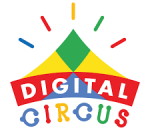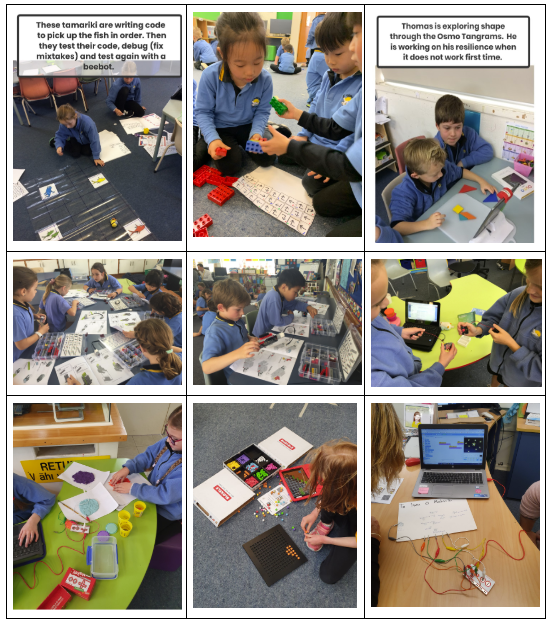What is Digital Technologies & Hangarau Matihiko (DT & HM) ?
Digital Technologies & Hangarau Matihiko is about teaching our tamariki how technology works, and how they can use that knowledge to solve problems.
Our learners need to have an understanding of digital technologies to succeed today and in the future. Even if they don’t go into “tech industry” careers they will need digital technology skills, knowledge and capabilities to fully participate in society. It is about helping students to develop as digitally capable thinkers, producers and creators.
A digitally fluent person can decide when, why and how to use specific digital technologies to perform a task or solve problems. A digitally capable person uses technology to find a solution. eg. checking online before going to a movie rather than arriving at the theatre to find it fully booked.
This isn’t about teaching students how to use digital devices, it’s about giving them an understanding of computer science principles and programmes. This will enable them to learn how to design their own digital solutions and become creators, not just consumers of digital technologies.
Digital Technologies and Hangarau Matihiko curriculum content will be taught from Years 1-10, with the option to specialise from Years 11-13.
At Torbay School we have been teaching some of these skills for a long time through different areas of the curriculum like; giving and following instructions, correcting ourselves when we make mistakes, and solving real life problems.
The two new areas to the curriculum are:
Computational Thinking
Learning to break down problems, create a set of instructions or steps, trial it and then check for mistakes both digitally and ‘unplugged’.
Designing and Developing Digital Outcomes
Students creating digital solutions to solve a problem or need. As well as understanding the role of technology in our lives and how it works.
 Professional Development has been provided by Digital Circus so that staff are confident in teaching the two new areas.
Professional Development has been provided by Digital Circus so that staff are confident in teaching the two new areas.
Some of the examples of learning are:
- Coding on Scratch – making games or animations
- Recording and sorting data
- Building an app
- Creating and researching to make a quiz
- Creating and researching to make a website
- Creating posters online
- Making podcasts/ radio/ & broadcasts
- Making e Books
- Robotics
Link to slideshow with more photos – CLICK HERE
Whānau Digital Playground
This morning Torbay School along with Digital Circus held an open day to share learning. Students demonstrated various activities and whānau had an opportunity to have a go.
Parent Feedback
“I have just been to the Digital Playground and wanted to thank you for welcoming families to see what amazing things are happening with ICT at Torbay. As a high school teacher I have concerns about balancing device use and more traditional skills, but this morning, my eyes were opened to a whole new world of engaging, creative and positive educational opportunities. Thank you for providing all these opportunities to the students. I am looking forward to learning about it all too!”
“Fabulous, insightful, great to see so much knowledge. Thank you.”
“That was so cool!! All the kids were engaged and proud to show all this awesome stuff to parents”
Digital Technology Survey – click here Information from the survey will be used for future planning.
OTHER NOTICES
Tēnā koutou katoa
This email is about the Ministry of Civil Defence & Emergency Management’s upcoming emergency mobile alert test on Sunday 24 November.
NZQA suggests checking to ensure your international students (and where appropriate, their parents/caregivers) are informed about the test so as not to alarm them – it is only a test.
The Ministry wants to make sure all New Zealanders with a mobile phone, including visitors such as international students, are aware of the upcoming mobile alert test.
Emergency Mobile Alerts are messages about emergencies sent by authorised emergency agencies to capable mobile phones. The alerts are designed to keep people safe and are broadcast to all capable phones from targeted cell towers. They can be targeted to areas affected by serious hazards and will only be sent when there is a serious threat to life, health or property, and, in some cases, for test purposes.
An advertising campaign will run from 17-24 November on TV, radio and online, along with other communications activity.
Attached is messaging about the alert, along with downloadable resources including posters, graphics and banners for social media.
We apologise if you have already received this information from other channels.
If you have any questions, please contact:
Ministry of Civil Defence & Emergency Management
- 70-84 Lambton Quay
PO Box 5010
Wellington 6145 - 04 830 5100
- 04 817 8554
- emergency.management@dpmc.govt.nz
- www.civildefence.govt.nz
#DOINGITFORHOLLIE




